Walberg dribble-drive attack
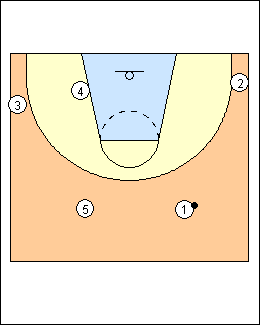 | 1 Vance Walberg Think 3 or key, they like 3's, love layups. Get to the rack (the basket) with a chance for an extra point with a kick-out 3 or a foul. Spacing, opening gaps, and getting to the rack are important. 1 is a traditional point guard, he brings the ball up the right side. 2 is a traditional 2, a good shooter, in the right corner with both feet above the rim line (there is a double gap between 1 and 2). 3 is also a shooter, one big step above 2 on the other side. 5 is a second point guard and can attack the basket. 1 and 5 are drivers-shooters (attackers), 2 and 3 are shooters-drivers. FIBA Assist, issue 35 - 5 inbounds, if you play a second big, you can put him at the 3. When the ball is in the backcourt, 2 and 3 are above the foul-line extended, 1 will advance pass any time he can. When the ball enters the frontcourt, 2 and 3 slide down. 4 is a rim runner, then gets both feet below the left block at an angle where he can see the ball coming up. He would be in the way on the other side, and it is harder to score back to the basket than shoulders to the basket. Tony Bergeron - 5 is one step behind ball level. |
 | 2 The dribble-drive attack uses the terms breakdown zone, drop zone, drag zone, and rack zone. The breakdown zone is where 1 decides how the defence is playing and what he is going to do. He wants to get to the rack zone. |
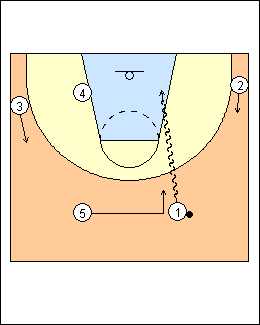 | Lane Penetration On lane penetration by 1, he drives up the lane on his side. 5 drags over behind then moves up. Once 1 gets past the drop zone, 3 elevates (drags up) to an open window where 1 can see him, 4 gets in clean-up position, forward pivoting on his inside foot to face the basket and not let X3 get inside. 2 moves up a bit, but 1 is not looking at him, he is looking at the rack or to lob to 4 if X4 helps (or get it high off the backboard). If X5 helps, 1 will reverse pivot on his inside foot and pass back to 5. Be at the NBA 3-point line so you can step into your shot. The drag zone is between the drop zone and the rack zone. Deep in the drag zone, eliminate the 2, it's pretty tough to get it to 3, 1 wants to reverse pivot and go back to 5 (Drag 5). Early in the drag zone look for 3. If X4 helps on 1 and X3 helps on 4, 1 skips to 3, 4 posts (Drag 3). Once you break the 3-point line without the ball, go to the rack as hard as you can, then get out as fast as you can if you don't get the ball. FIBA Assist - once 1 gets past the drop zone, 3 drags up and 5 drags behind, 4 gets into clean-up, 2 has to be patient in his corner and not elevate up. A pass to 2 is an option if X2 helps early on the drive. Stan Peters (coachesclipboard.ca) - the drag zone is below the foul-line extended to just above the low lane box. Defenders will be "dragged" into help positions, especially from the weakside, opening up weakside shooters. Spacing and passing angles to the ballside wing are not very good, but they will pass if he is wide open. Avery Johnson - 5 is pressure release if 1 gets trapped. |
 | 4 On a pass to drag 5, 1 comes off 4, 3 moves up. 5 looks for lane or middle penetration. |
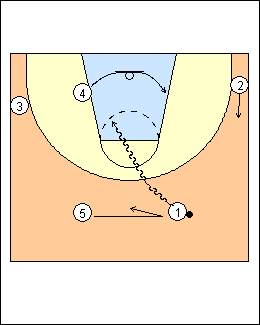 | Middle penetration (kickback) On middle penetration by 1, 5 comes behind (a kickback) with a 6-8 feet gap, then drags behind again. 1 pitches it back if X5 helps, 5 attacks (racks it). 5 should be in line with the rim and the ball (positive kickback), which gives a great chance of scoring. 1 is coming towards 4, so he relocates, circling under to the other side, leaving an open lane. 2 and 3 must be patient. 2 moves up one big step. 1 ignores 3, the only pass he has is a lob except if X3 comes in quick to help, too fast. It is tough to get the ball to the wing on your side when you get in deep. Tony Bergeron - as soon as 1 gets below 5, 5 speeds straight across behind him (over the top), or 5 can backcut if overplayed. 1 jump stops, reverse pivots and kicks back to 5 if he gets in trouble, 5 will turn and drive if X5 stays behind. 1 can kick back then ballscreen for a middle drive by 5. |
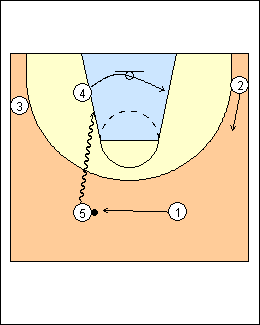 | 6 On lane penetration by 5, 4 relocates, 2 moves up to the open window, 1 drags behind. |
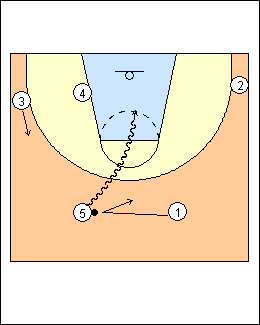 | 7 On middle penetration by 5, 4 cleans up, 1 kicks back then drags behind, 3 elevates to the open window. |
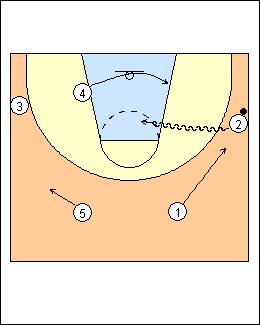 | 8 Wing penetration If 2 penetrates middle, 4 relocates looking for a little dump pass, 1 kicks back behind 2, 5 finds "whatever is open over there". Send three to the boards every time plus the shooter. The safety gets back only to above the arc, dragging back for a quick 3 if there is an offensive rebound. |
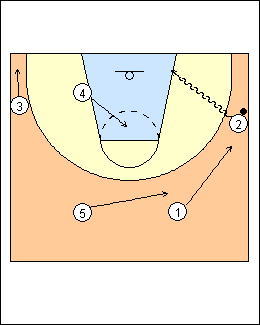 | 9 On baseline penetration, 1 drags in behind, 5 finds the open window up top, 4 tees up below the nail, 3 is in the corner ready to catch and shoot. 2 can jump out of bounds and pass to 3 with one hand. If 2 gets stuck, reverse pivot and pass back to 1. |
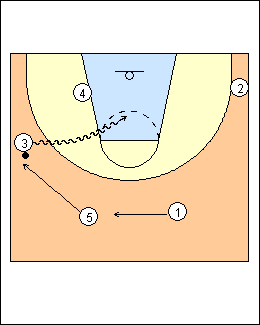 | 10 If 3 penetrates middle, 4 cleans up, 5 comes behind, 1 finds the open window. 2 is in the corner, any time the ball goes to one wing, the other wing should be on a diagonal. If 3 passes to 2, 3 has to space out (weakside), then 1 gives 2 a two-count before moving over. Walberg does not like baseline penetration by 3, the defence will trap it. 3 only goes middle. |
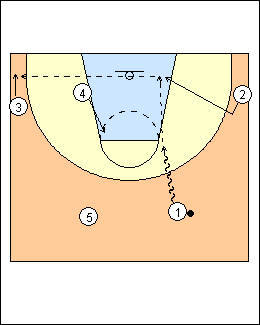 | Drop Zone Drop 2 If 1 knows he can't get to the rack zone, they want him to stop in the drop zone, it becomes a 1-2 game, 1 is looking for 2 to go backdoor. 1 jump stops, ball fakes, 2 takes one step up, yells "ball", shows both hands, and cuts through hard. X4 will help, so when 1 stops in the drop zone 4 tees up (like a baseline drive), 3 goes to the corner. If 2 is a shooter, it opens up gaps for 1. FIBA Assist - 2 stays in the corner until he sees that 1 has picked up his dribble. When 4 recognizes that 1 has stopped in the drop zone, he flashes high to the opposite elbow calling for the ball. When 1 passes to 2, 3 stays in the corner looking for the baseline skip pass. Herb Welling - 4 comes up to the drop 3 zone (Jerry Auger, guelphbasketball.com). Stan Peters - the drop zone is the area inside the 3-point line down to the foul-line extended. A drop zone jump stop signals the post to get to the weakside elbow, and a kickdown, kickup or backcut by the ballside wing. Tony Bergeron - 4 would come up as soon as he sees the backdoor. Jerry Petitgoue - 2 takes two steps out of the corner then backcuts hard, 4 moves up to the weakside elbow when he sees that. Comment - 3 and 4 don't know on the jump stop that 2 will backcut, so optionally have them wait until they see a backcut. Otherwise there is no option of a pass from 1 to weakside 3. |
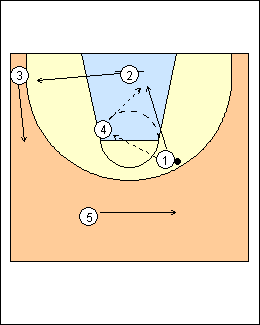 | 12 If 2 isn't open he goes out the other side, 1 looks to pass to 4 for a give and go (a 1-4 game). 5 drags behind 1. If there is no return pass to 1, 4 pass fakes and 1 follows 2 to give 4 a quick clear-out (2 and 3 elevate). |
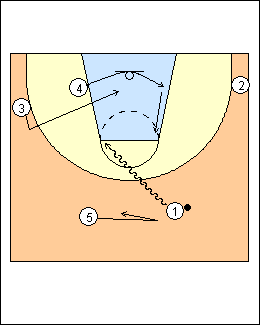 | Drop 3 1 drives middle, 5 kicks back then drags, 4 relocates then tees up as 1 stops and 3 backcuts, 2 is in the corner. If 3 is not open, look for a pass to 4 and a give and go or clear-out. |
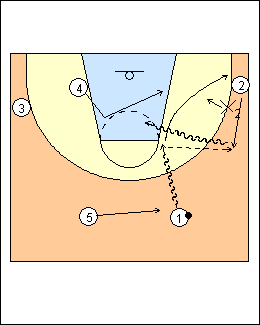 | Kickups 1 drives to the drop zone, instead of hugging 2, X2 opens up to defend the backdoor, 2 continues to kick up for a pass, will try to drive middle right away, 1 cuts to the corner. 4 starts to tee up then dives to the ballside post when he sees the kickup coming, opening up a middle drive for 2. 2 should not be moving up when 1 hits him, i.e., the kickup should be positive not negative, so he can attack downhill. 5 would kickback when 2 drives middle. FIBA Assist - 2 comes up because they are overplaying the backdoor, when 2 goes middle penetration, 4 relocates, 3 stays patient in his corner, 5 does a kickback. Jerry Petitgoue - 2 drives middle, 5 is right behind him, 4 is going to be opposite the ball so he floats other side. If X4 helps on 2, 2 can pass back to 1 in the corner then clear weakside, 4 pins for a pass from 1. Comment - if 4 dives to the ballside block when he sees a kickup coming, he would be in the way if 2 happens to drive baseline, so optionally have 4 clean up then relocate only when he sees a middle drive by 2 (or tee up if he sees a backcut). |
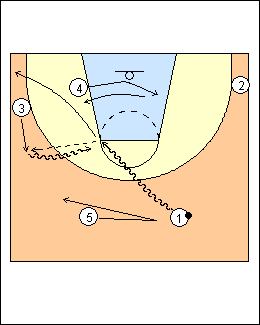 | Drop 3 kickup 1 drives middle, 3 kicks up for a pass, 1 cuts to the corner, 3 drives middle. 4 starts relocating then comes right back when he sees the kickup. 5 kicks back, drags, then kicks back again when 3 drives middle. Note that 4 does not start to tee up. Against good teams, combination attacks are needed, e.g., - drop 3 kickup (1 to 3) to drop 2 (3 to 2 backdoor) - kickback (1 to 5) to kickup (5 to 2) to drop 3 (2 to 3 backdoor). |
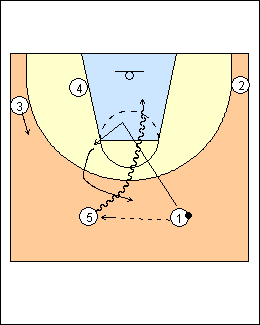 | Playing in the gap 415 (4 set, 1 to 5) The best gap is a triple gap. 1 passes to 5, busts looking for the ball then loops back (tees up), opening up a triple gap for 5, who racks it. 4 cleans up, 3 elevates to an open window, 1 keeps going. If defenders switch, don't tee it, 1 goes through. Look for a 415 to drop 2 (1 to 5 to 2 backdoor). New Jersey Nets dribble-drive - 5 can cut to the ballside elbow area, creating space for a middle drive by 1, 4 relocates. |
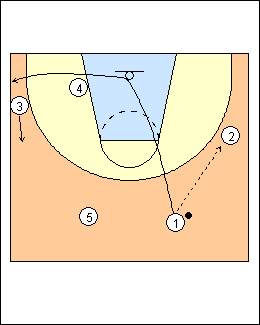 | If we are dribbling too much, elevate 2 for a pass, 1 cuts hard to the hoop and comes out (the rule any time you pass, then don't get it), 3 elevates, 5 gives 2 a two-count before moving over. On a middle drive by 2, 4 would relocate and 5 kickback. If 1 advance passes to 2 from the backcourt, 1 cuts through weakside if 2 hesitates. Jerry Petitgoue - they don't drive baseline very often (teams load up on that), but on "through", 1 passes to 2 and goes through. They want a baseline drive by 2, 4 goes to the front of the rim, 5 fills behind 2. If 2 passes back to 5, he clears through. |
 | Dribble push If 2 elevates and is overplayed, he backcuts if 1 ball fakes or dribbles at him (not an attack dribble). 2 doesn't need to set it up, he just goes. 1 looks to attack baseline, 5 gives him a two-count before coming over (unless 1 picks up his dribble). On a pass to 5, 1 would drop down to the corner to open up a double gap. Stan Peters - 1 waves through 2. |
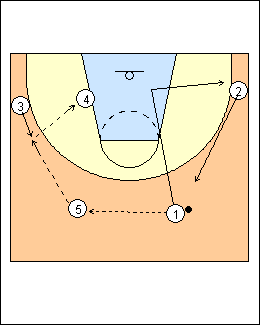 | 4 will get a lot of points if he is smart and can clean up and relocate. If you want to get him the ball, 1 holds on a pass to 5, 3 pops up for a pass and gets it inside. On the pass to 4, the opposite high player dives then clears, the opposite diagonal elevates. 4 should make a half turn inside (forward pivot bottom foot) to see what's open. He can drop step and dribble, but no standing dribble. On a pass from 4 to 2, 5 would basket cut to open up a gap. In sum, attacking options are - rack it - 1 to 5, tee it, triple gap - 1 to 2, cut - dribble push 2 - 1 to 5 to 3 to 4 inside. Ballscreens can be added. Tony Bergeron - 5, 2 or 4 can ballscreen for 1. Ballscreen with 4 to get a big defender out of the post, 5 will go over the top or can backcut. |
This page was made with Basketball playbook from Jes-Soft